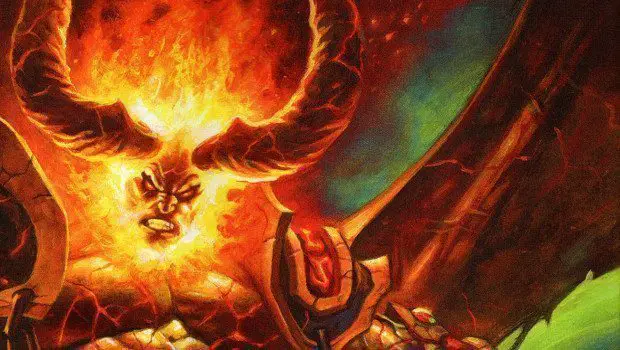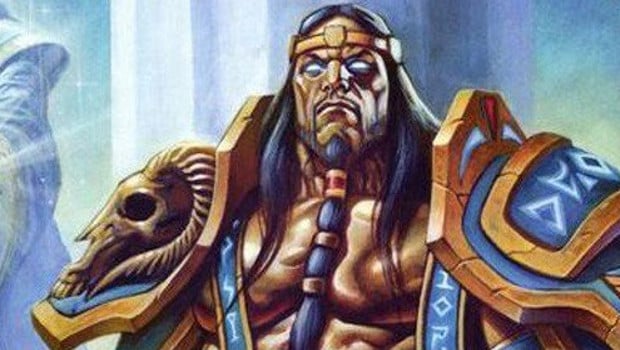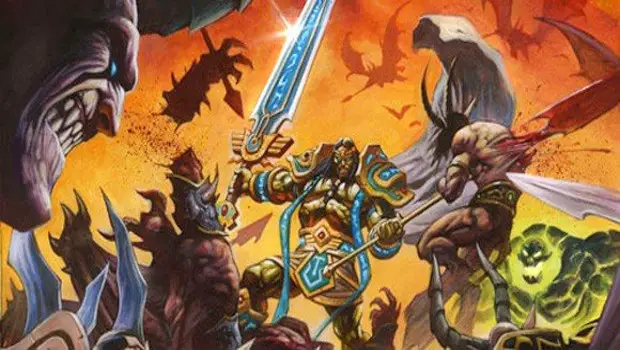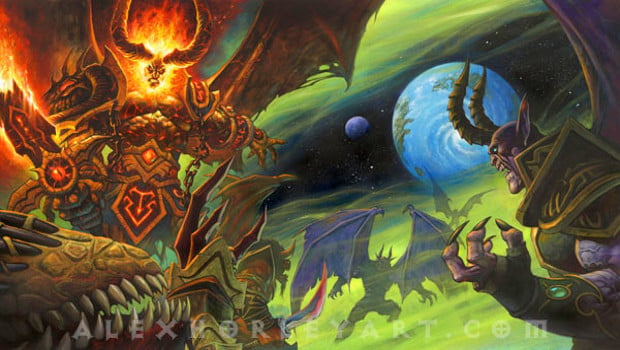Know Your Lore: The fall of Sargeras

Know Your Lore is our weekly column about the lore behind Blizzard games. This time, we explore Sargeras, the ultimate evil of the Warcraft setting.
It’s actually disingenuous to call Sargeras “the ultimate evil,” although it’s also accurate. At present, through his own machinations, Sargeras is helpless to act directly — the destroyer was in the body of Medivh when the last Guardian was slain, and this left the fallen Titan in the Twisting Nether, bereft of form. Yet his machinations live on. The legacy of Sargeras by itself would be enough to terrify any sane folk. The fallen Titan unleashed the Burning Legion and sent them across infinity, devouring worlds like cosmic locusts, rendering them lifeless. A nearly unstoppable army of demons under his banner finds worlds and unmakes them, and so far only one planet has held out against the onslaught of Sargeras and his Burning Legion.
But who is Sargeras? What motivates this being? What drives him to seek the unmaking of the entire universe?
The Champion of the Pantheon
We don’t know the origins of the Pantheon, or of the Titans themselves. We do know that at some point in the distant past these god-like beings arose and decided to impose order onto the chaos of existence. Worlds upon worlds, hundreds of millions or more, were shaped by them. Oceans, atmosphere, even the unknowable depths of their cthonic hearts were formed and shaped by the works of the Titans. For whatever reason the Titans found the state of the universe unacceptable, the chaos of the dawn of existence a defect to be created, and somehow the ordering of worlds would serve to bring that order to all things, transforming the universe into an act of creation.
It was an ambitious plan, and not without its obstacles to overcome. First there were the entities known to us as Old Gods — the Titans viewed them as parasitic organisms infesting planets, to be rooted out if possible and contained if not, like an infection. But as unfathomable and abhorrent as the Old Gods were, the demons of the Twisting Nether were an alien threat, from an outside reality. And the Pantheon required a means to prevent both from interfering with their plans for the vast cosmos.
And so they selected Sargeras, one of their greatest, to be their champion. Sargeras was deemed the most noble of the Titans, their greatest champion, their most devoted protector. The Champion of the Pantheon sought out and confronted evil throughout creation, rooting it out and destroying it, or imprisoning it if it would not be destroyed. Such was the fate of many entities such as the Nathrezim who upon destruction in this reality would simply reform in the Nether — Sargeras contained their depraved essences in prison planes carved out of the very Nether itself.
And so Sargeras defended the Titans and their works for countless millennia. But neither Sargeras nor the others of the Pantheon could truly conceive of evil on a cosmic scale – as beings of altruistic order, the kind of destroying, corrupting vileness Sargeras would be forced to confront was beyond their ability to understand. And so Sargeras began to despair — his task seemed insurmountable even for him, one of the greatest of the Titans. And if the task was beyond the Titans, then the goal of imposing order on creation was futile. Order itself was a lie, Sargeras came to believe.
And so he fell.
The Defender becomes the Destroyer
The fallen Titan didn’t fall in a day, nor did he abandon his desire to see creation orderly and perfected. He simply came to believe that entities such as the Nathrezim proved that the cosmos as it existed could not be made orderly and that his fellow Titans were misguided or willfully blind to the defect. Their inability to understand true evil was their blind spot showing — with the scales lifted from his eyes, Sargeras would destroy everything and then a perfect creation could be achieved. Unable to convince the Pantheon of this, he departed from their ranks and sought an instrument of his new design.
First he breached the prisons he had created in the Nether and recruited those who he had himself trapped there, such as the Nathrezim dreadlords, the insidious demons of corruption who had troubled him during his original service. He knew they would not be enough, however — he sought more than mere corruption, he sought the utter ruin of existence itself. Only when everything was destroyed could perfection be realized. The Nathrezim would be a tool, but they couldn’t be entrusted with the campaign to unmake infinity.
Sargeras enlisted or created more demons to fill his ranks. The brutal Annihilan pit lords, the Shivan, the seductive Sayyad all came to serve him, but none of these were suitable to lead the army he intended to create. Finally, disappointed by each, he resolved to create the war leaders he required. On the world of Argus, Sargeras found the Eredar, and through skillful manipulation and offers of cosmic power and knowledge he bound them to his service, infusing the vast majority of the race with fel energies and twisting them into demons. This act was the true creation of the Burning Legion, as the Eredar assumed their intended role as the generals of Sargeras’ infinite army and brought destruction on a cosmic scale to the universe.
The Legion Marches
For fifteen thousand years, everywhere the Legion went, they destroyed. Worlds fell before their endless rampage across creation. His left and right hands, Kil’jaeden the Deceiver and Archimonde the Defiler, executed his grand vision effectively, although Kil’jaeden himself was slightly distracted by his unending hunt for his former “brother” Velen and those of the Eredar people who had rejected Sargeras’ offer. The fallen Titan himself, however, was unconcerned for the fate of these “exiles,” or Draenei in the original Eredar language. Their destruction would come in time.
No, Sargeras had discovered a singular world. Alone among the Titan’s creations it possessed a font of pure arcane potency, a Well of Eternity that promised to allow the dark Titan to grow powerful enough to challenge the rest of the Pantheon directly and bring the Crusade to a quicker end than the inexorable march across the cosmos. Instead of merely unmaking their works, he could stop them, once and for all. Once he was in charge, either through the Pantheon’s subjugation or its destruction, Sargeras could end this clockwork universe and start anew.
Next week, we tell the story of Sargeras’ first assault upon Azeroth, the rise and fall of the Guardians of Tirisfal, and a Tomb.
Please consider supporting our Patreon!
Join the Discussion
Blizzard Watch is a safe space for all readers. By leaving comments on this site you agree to follow our commenting and community guidelines.
 @MatthewWRossi
@MatthewWRossi






